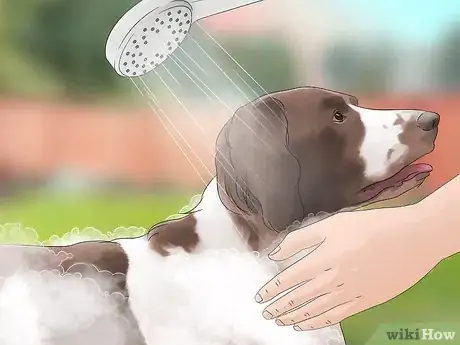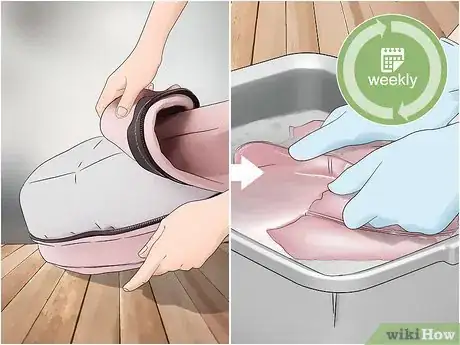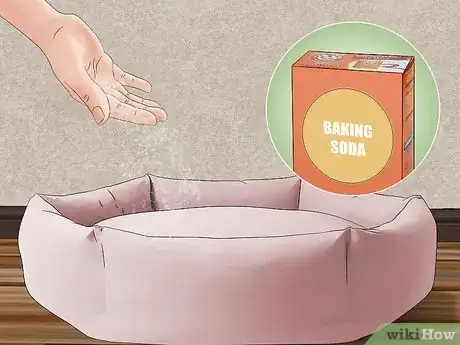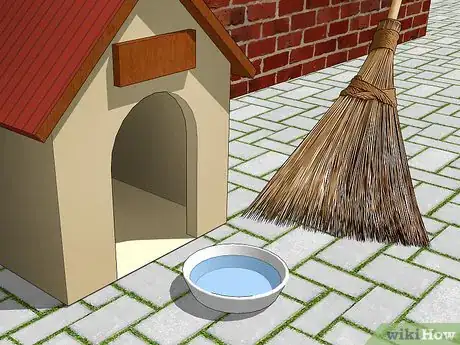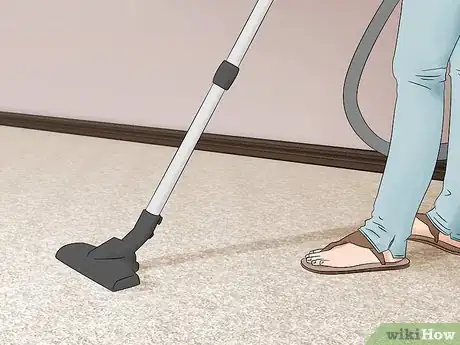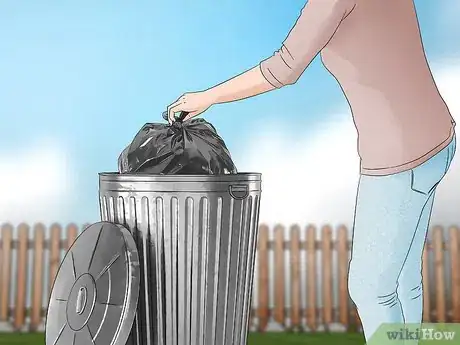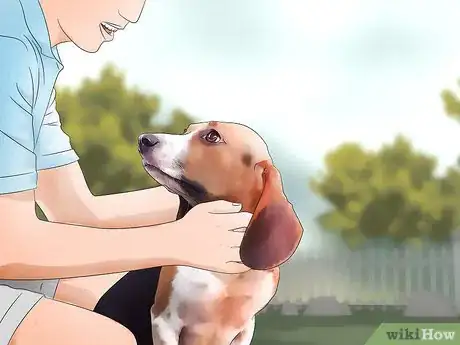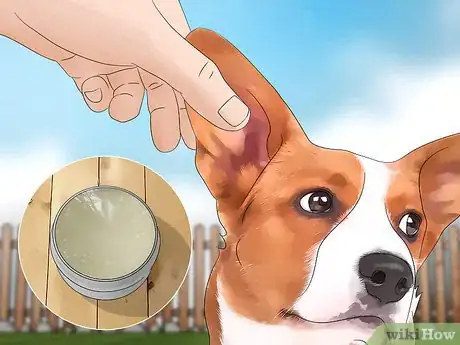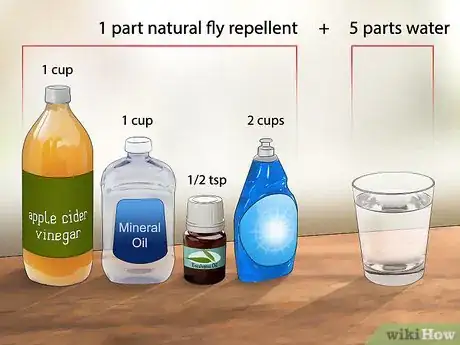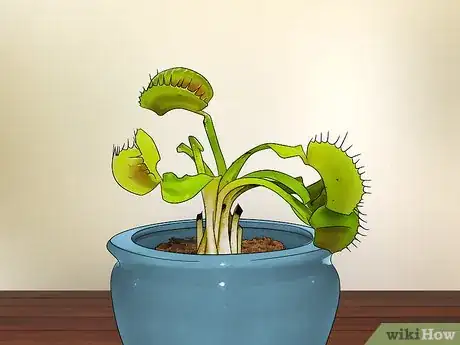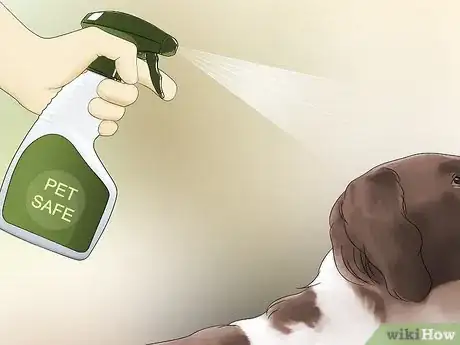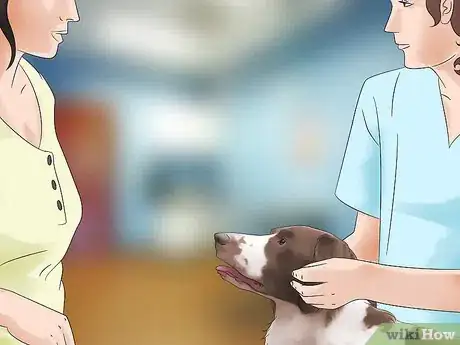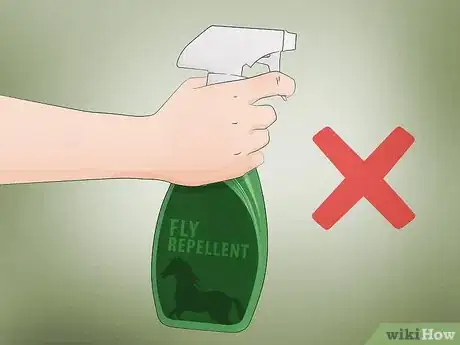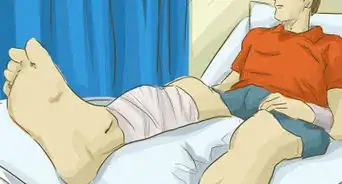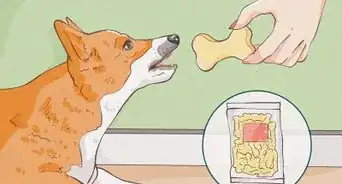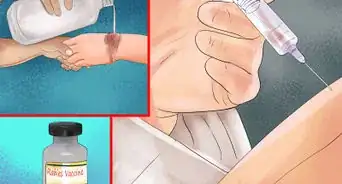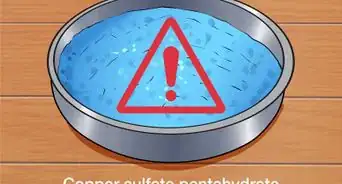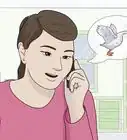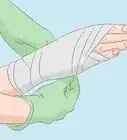This article was co-authored by Pippa Elliott, MRCVS. Dr. Elliott, BVMS, MRCVS is a veterinarian with over 30 years of experience in veterinary surgery and companion animal practice. She graduated from the University of Glasgow in 1987 with a degree in veterinary medicine and surgery. She has worked at the same animal clinic in her hometown for over 20 years.
There are 7 references cited in this article, which can be found at the bottom of the page.
This article has been viewed 134,268 times.
If your home has a fly infestation, your dog may be suffering more than you know. Not only can flies annoy dogs, but fly bites can also irritate the skin and cause infections. Getting flies off of your dog and preventing further bites can be as simple as changing your cleaning habits and using everyday cleaners. Grooming your dog often, cleaning your home regularly, and using fly repellants can all keep these pests away from your dog.
Steps
Grooming and Training Your Dog
-
1Groom your dog regularly to prevent attracting flies. Flies gravitate towards dirt and bad odors. If your dog is brushed and bathed once or twice a month, they are less likely to attract flies. Brush and bathe your dog in addition to their monthly grooming session whenever you notice flies targeting your dog, especially during the summer months when flies are more active.
- Make sure you're cleaning and trimming the fur around your dog's anus and genitals so it doesn't get matted or dirty.
-
2House train your dog. Flies often lay their eggs in fecal matter. If your dog has poor hygiene, they will be more susceptible to fly bites. Train your dog to toilet in a specific area of the yard to make cleanup easier. Set up a daily toileting routine for your dog and reward them for relieving themselves in the designated area.[1]Advertisement
-
3Wash your dog's bedding at least once a week. Cleaning your dog bedding will prevent it from accumulating smells or stains and get rid of any fly eggs that might be hiding in the fabric. Hand or machine wash your dog bedding with a pet-friendly soap and hot water once a week to keep it free from dirt, odors, or fly eggs.[2]
-
4Sprinkle baking soda on your dog's bedding to get rid of lingering odors. If your dog's bedding still smells unpleasant after washing it, baking soda may get rid of the scent. Sprinkle a little baking soda on the bedding, leave it for about 15 minutes and then vacuum it up. Re-apply the baking soda as needed or whenever you wash your dog's bedding to keep the bedding smelling fresh.[3]
Preventing Fly Infestations
-
1Clean up dog food or bones around your dog's kennel immediately. Do not leave dog food or bones out, as flies are attracted to open food sources. Set specific meal times for your dog to prevent their living space from becoming infested with flies.[4]
-
2Vacuum your carpets several times a week. If your dog is often bothered by flies in your home, you may have an infestation. Regularly vacuuming your carpet will help you pick up any fly eggs on the ground that may be unseen by the naked eye. After vacuuming your home, empty the vacuum cleaner outside to prevent reinfestation.
-
3Clean up any trash or waste in your home or yard. Because flies thrive in dirty conditions, keeping your dog's living areas well-maintained is important for preventing fly bites. Throw away any garbage, dog waste, or old food as you see it to avoid unpleasant smells, which can attract flies quickly.[5]
-
4Bring your dog inside during the hottest times of the day. Flies are most active during the summer months, especially during the day. The hotter the temperature, the more likely your dog is to be infested with flies. Keep your dog indoors during the late morning and afternoon to prevent fly bites.[6]
Trying Natural or Chemical Fly Repellants
-
1Apply petroleum jelly to your dog's ears. If your dog's ears are often bitten by flies, apply a thin coating of petroleum jelly to the area. Squirt a small amount of petroleum jelly into your hand and rub it into both sides of your dog's ears. This will prevent flies from landing there again and give your dog's wounds time to heal.[7]
- Open bite wounds can attract more flies, so applying petroleum jelly to your dog's ears is important to prevent more irritation.
-
2Make a fly repellent from vinegar, mineral oil, and scented essential oils. If you want to avoid spraying your dog with chemical repellents, mix 1 cup (240 ml) of apple cider vinegar and 1 cup (240 ml) of mineral oil with 1⁄2 teaspoon (2.5 ml) of the following essential oils: citronella, lemongrass, bitter orange, eucalyptus, and clove. Finish the mixture with 2 cups (470 ml) of dish soap, then mix 1 part of the natural fly repellent with 5 parts water. Spray your dog with the fly repellent, targeting areas that flies often land on.
- Keep in mind that this repellent isn't proven to be safe or effective.
-
3Hang up fly traps or buy fly-trapping plants. Hangable fly traps stay out of a dog's reach while catching any flies that may be in the house. If, for whatever reason, you are against fly traps, purchase a Venus flytrap or other carnivorous plant to naturally lower your fly infestation.[8]
- Venus flytraps can be grown outdoors or by a windowsill. They require routine care and maintenance to keep healthy.
-
4Light a few citronella candles in your home. Citronella is a scent that's safe for dogs and that insects find repellant. If you would prefer not to kill flies, purchase several citronella candles and use them in the rooms your dog most often frequents.[9]
- Other citronella-based fragrances, like essential oils or cleaning sprays, can also repel insects but flies find smoke most repulsive.
- Never leave your candle unattended or low enough that your pet could knock it over.
-
5Buy a pet-safe chemical fly repellent. Not all fly repellents are pet-safe, so read the instructions carefully before purchasing one for your pet. Avoid buying fly repellents that are not explicitly made for dogs. Apply the fly repellent to your dog or its belongings daily or as instructed by the fly repellent to keep flies far from your dog.
- Fly repellents made from pyrethrum are usually non-toxic and safe for dogs.[10]
- Pet-safe fly repellants are available online or at most pet stores.
-
6Ask your veterinarian about prescribed balms or dog-safe cleaners. If your dog is frequently targeted by flies, bring them to a local vet for an antibiotic cream. Let your veterinarian know about any fly repellents you're currently using, and ask them for recommendations on natural or chemical fly repellents that are safe for your dog.
-
7Avoid fly repellents that are not specifically dog-safe. Even if a cleaner is safe for humans, it still may be harmful or even deadly to dogs. If a cleaner is not specifically marked "dog-safe" or has not been recommended by your veterinarian, do not apply it to your dog.
Warnings
- Read the instruction and warning labels of any chemical cleaners so you can use them safely.⧼thumbs_response⧽
References
- ↑ https://www.vetbabble.com/dogs/health-dogs/dog-bothered-by-flies/
- ↑ http://www.lifewithdogs.tv/2016/05/natural-flea-tick-fly-mosquito-repellent-for-dogs-and-their-people/
- ↑ https://www.mnn.com/your-home/at-home/stories/the-never-ending-uses-of-baking-soda
- ↑ https://www.vetbabble.com/dogs/health-dogs/dog-bothered-by-flies/
- ↑ https://www.petmd.com/dog/care/evr_dg_how-to-keep-flies-off-dogs
- ↑ http://www.canismajor.com/dog/critter.html#Flies
- ↑ https://www.petmd.com/dog/care/evr_dg_how-to-keep-flies-off-dogs
- ↑ https://homesteading.com/get-rid-flies-outdoors/
- ↑ http://www.naturallivingideas.com/how-to-naturally-keep-flies-away/
About This Article
To keep flies off dogs, start by making a fly repellent from vinegar, mineral oil, and scented essential oils such as citronella, lemongrass, or clove. Once the repellent is ready, spray your dog with it, focusing on the areas that the flies most often land on. Alternatively, you can buy a pet-safe chemical fly repellent and put it on your dog and its belongings daily. If the dog's ears seem to be the most troublesome area, put petroleum jelly on them to deter flies. For more tips from our Veterinarian reviewer, including how to prevent fly infestations, keep reading!
